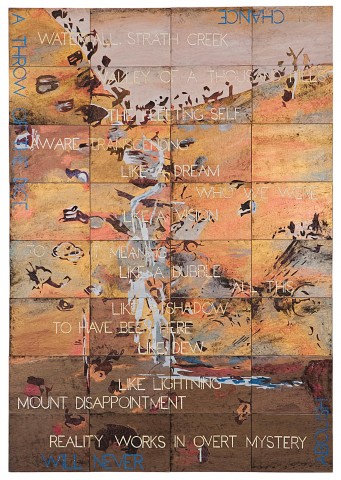WATERFALL (AFTER WILLIAMS), 2011
IMANTS TILLERS
synthetic polymer paint on 32 canvas boards
203.0 x 142.0 cm (overall)
each panel numbered sequentially with stencil verso: 89282 – 89313
Private collection, New South Wales
The Archibald, Wynne and Sulman Prizes, Art Gallery of New South Wales, Sydney, 31 Mar – 12 June 2012 and touring (Winner, Wynne Prize)
Imants Tillers The Fleeting Self, ARC ONE Gallery, Melbourne, 18 June – 20 July 2013
Allen, C., ‘Oh no, not you again – The Archibald, Sulman and Wynne prizes’, The Australian, Sydney, 21 April 2012
Mendelssohn, J., ‘Times change but the art establishment rolls on’, The Conversation, 2 April 2013 [https://theconversation.com/times-change-but-the-art-establishment-rolls... (illus.)
Eugene von Guérard, Waterfall, Strath Creek, 1862, oil on canvas, 83.2 x 65.7 cm, in the collection of the Art Gallery of New South Wales, Sydney
Fred Williams, Untitled, [Free copy of Eugene Von Guerard's Waterfall, Strath Creek, 1862], 1970, gouache on paper, 60.2 x 37.4 cm, in the collection of the National Gallery of Australia, Canberra
Imants Tillers, Untitled (Deaf), 1989, synthetic polymer paint on 48 canvas boards, 213 x 165 cm, in the collection of TarraWarra Museum of Art, Victoria, gift of Eva Besen and Marc Besen AO
Eugene von Guérard’s 1862 masterpiece, Waterfall, Strath Creek, although modest in scale, encapsulates the Romantic sense of awe and scientific exactitude that would propel the Austrian artist to the status of one of Australia’s greatest colonial painters. Waterfall, Strath Creek at the Art Gallery of New South Wales became a touchstone of Australian landscape painting for contemporary artists. During the 1970s and 1980s, its dynamic composition was reprised several times in a chain of appropriation that would ultimately culminate with Imants Tillers’ magnificent, Wynne prize-winning painting: Waterfall (After Williams), 2011. Speaking of his work at the Art Gallery of New South Wales in 2012, Tillers explained that the painting could be more aptly described as a ‘meditation on landscape’ in the wake of the revolution of aboriginal landscape painting.1
Key to Tillers’ work is the idea that the landscape is a constructed space, the product of a highly mediated conception of nature. A postmodern artist par excellence, Tillers longstanding artistic practice has been founded on its devices: appropriation, grid-based enlargement and reproduction and application of text and stencilled overlay on the painted surface. Waterfall (After Williams) is, in fact, thrice removed from the original subject, the 50m valley through which flows the Strath Creek waterfall, in the thickly timbered country of Victoria’s Mount Disappointment. Von Guérard visited this site in January of 1862, as did Fred Williams in 1970 when he painted Free copy of Eugene Von Guerard’s Waterfall Strath Creek, now held in the National Gallery of Australia. Tillers did not go so far, choosing instead to appropriate Fred William’s gouache plein-air study, translating its painterly gestures into graphic, stencilled silhouettes. Further obscured under layers of text, the final image ofWaterfall (After Williams) bears little resemblance to von Guérard’s original detailed naturalist painting. As an interpretation of an interpretation, Tillers’ work speaks to the idea of flux and transience, with the waterfall a metaphor for an everchanging landscape.
Over a hundred years after von Guérard, contemporary artist William Delafield Cook sat at the same spot in the bottom of the valley, looking up towards its V-shaped ravine, recording the scene with his own signature photographic realism. The resulting vast painting of a parched and bleached summer landscape won the Wynne prize in 1980 and was acquired for the Art Gallery of New South Wales’ collection the following year.2 Fred Williams also returned to this subject in oil paint to attempt to capture the spectacular scale of the falls.
Continuing this chain of dialogue between the landscape and his artistic forefathers, in 1989 Imants Tillers painted Untitled (Deaf), which was a closer reprisal of von Guérard’s Waterfall, Strath Creek, overlaid with a decorative arabesque appropriated from American artist Philipp Taaffe’s Now and Then, 1988. Executed in vertically oriented canvas boards, Untitled (Deaf) initiated Tillers’ own part in this decades-long discussion of the mediated nature of Australian landscape painting. In this last iteration, of 2012, alongside the stanzas of an Indian sutra, ‘the fleeting self / like a dream/ like a vision’ over the canvas boards appear phrases that invite historical accountability and invite a re-assessment of the genre: ‘who we were/ all this / reality works in overt mystery / abolish / will never.’
1. The artist, 9 April 2012 [https://www.artgallery.nsw.gov.au/prizes/wynne/2012/29209/]
2. William Delafield Cook, A waterfall (Strath Creek), 1980 – 1, synthetic polymer paint on canvas,198.2 x 156.2 cm, in the collection of the Art Gallery of New South Wales, Sydney.
LUCIE REEVES-SMITH
